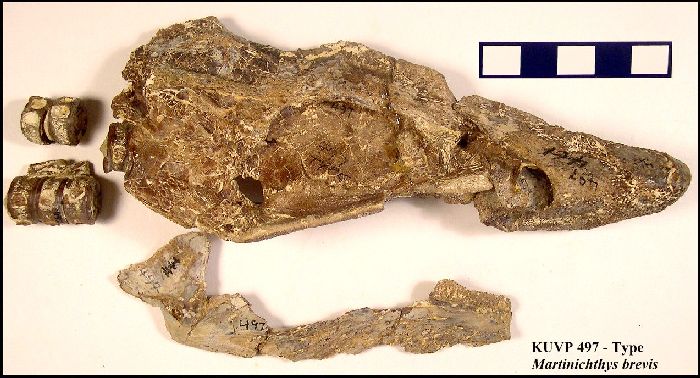 |
Martinichthys;
Mystery fish of the Smoky Hill Chalk
Copyright © 2000-2010 by Mike Everhart
Last updated 02/24/2010
LEFT: The skull of Martinichthys
brevis (KUVP 497); it is the only known, reasonably complete skull of this genus. |
Martinichthys is a rare and rather enigmatic fish whose remains have
been found only in the Smoky Hill Chalk of Kansas and only there in a very limited
stratigraphic range (latest Coniacian). It is a member of a group of fish called
plethodids. Plethodids are a fairly common but relatively primitive
group of medium sized, Late Cretaceous fish. The Family Plethodidae includes the genera: Niobrara, Zanclites, Luxilites, Syntegmodus, Bananogmius, Pentanogmius "Anogmius" evolutus, Martinichthys,
Thryptodus, and Plethodus (see OOK field guide to fishes for
more information). In the case of Martinichthys,
the rostrum, or snout, is the heaviest bone in the skeleton and most often preserved.
The rest of post cranial bones were apparently poorly ossified, and aside from two
specimens that include skull material and some vertebrae, are not known to be preserved.
 |
LEFT: An "as found" view of a small Martinichthys
rostrum (FHSM VP-15561 / EPC 1993-02) that I discovered in Gove County, KS., in 1993. It
appears quite possible that many of the rostra that are found represent the remains of a
meal by a larger predator. Several Martinichthys rostra have been found with definite bite marks. (Scale = inches) |
The earliest known specimen (AMNH 2131) in the American Museum of Natural
History was first reported (and first identified as the worn rostrum of a new species of Protosphyraena (Erisichthe ziphioides) by E. D. Cope in 1877. O. P. Hay took exception to Cope's
description and published a figure of the type specimen (below) in 1903. Like Cope, he
also had a problem in properly orienting and identifying the specimen, and repeated Cope's
error by calling it Protosphyraena ziphioides. It wasn't until additional
material, including a complete skull (KUVP 497 above) and a partial skull (KUVP 498), was
available in the University of Kansas collection, that C. E. McClung published his
paper describing six new species of Martinichthys as a new genus of Late
Cretaceous fish known only from Kansas. More recently, Taverne (1999), has reviewed the
genus and reduced the number of species to two (Martinichthys ziphioides and M.
brevis), with the type specimens of both species in the collection of the University
of Kansas Museum of Natural History.
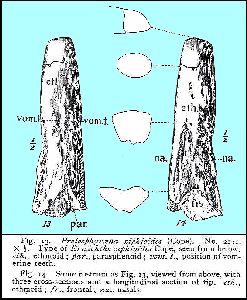 |
LEFT: The first known figure showing the rostrum of Martinichthys
ziphioides (Cope - AMNH FF 2131), originally published as Protosphyraena
ziphioides, by O. P. Hay in: On certain genera and species of North American
Cretaceous Actinopterous fishes, Bulletin of the American Museum of Natural History,
Vol. XIX, Figure 13, 1903. Although not quite as embarrassing as putting the head on the
wrong end of the plesiosaur, both Cope and Hay described the original specimen
'upside-down', with Cope calling it the "muzzle of an old individual [of the
primitive swordfish, Protosphyraena] which has lost a great deal of its apex by
attrition." The specimen was collected from the Smoky Hill Chalk of Gove County by
Charles H. Sternberg on June 9, 1877. (Figure adapted from Hay,
1903) |
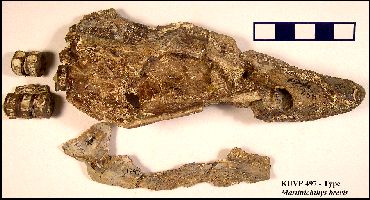 |
LEFT: The type specimen of Martinichthys brevis
(KUVP 497) in the collection of the Natural History Museum of The University of Kansas,
and the only known, reasonably complete skull of Martinichthys. This is the only
known publication of a picture of this skull since it was first described and published
with photographs in 1926 by C. E. McClung (A drawing of this skull was published by
Taverne, 2000). Note that there are five vertebrae associated with the skull.
(Scale = cm) |
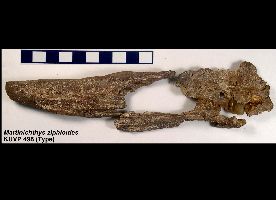 |
LEFT: The skull of the type specimens of Martinichthys
ziphioides (KUVP 498) in the collection of the Natural History Museum of The
University of Kansas. There are 21 vertebrae associated with this specimen. (Scale = cm) |
In 2003, Pam and I donated our entire collection (19 specimens) of Martinichthys
rostra to the Sternberg Museum of Natural History. Most of our specimens are shown below
with their new Sternberg (FHSM) number, and our original Everhart Paleontology Collection
(EPC) number:
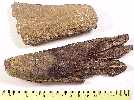 |
Dorsal and ventral views of two specimens: FHSM VP-15549 (EPC
1989-A) and FHSM VP-15553 (EPC 1990-16). |
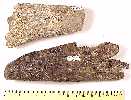 |
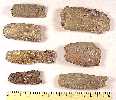 |
Dorsal and ventral views of seven specimens: FHSM VP-15558
(EPC 1991-27), FHSM VP-15557 (EPC 1991-14), FHSM VP-15562 (EPC 1995-21), FHSM VP-155561
(EPC 1993-02), FHSM VP-15552 (EPC 1989-33), FHSM VP-15550 (EPC 1989-11B) and FHSM VP
-15556 (EPC 1990-59). |
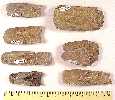 |
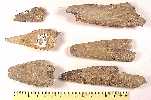 |
Dorsal and ventral views of 6 specimens: FHSM VP-15555 (EPC
1990-23), FHSM VP-15551 (EPC 1989-29), FHSM VP-15554 (EPC1990-25), FHSM VP 15563 (EPC
1995-40), FHSM VP-15559 (EPC 1992-10, mis-labeled as 1993-10) and FHSM VP-15560 (EPC
1992-35). |
 |
 |
A pair of 2003 discoveries of Martinichthys from Gove
County, Kansas. At left FHSM VP-15566 (EPC 2003-29) is the rostrum of a young M.
ziphioides; at right, FHSM VP-15567 (EPC 2003-34) is the rostrum of a much older adult
of M. brevis. Both of these specimens were found BELOW Marker Unit 3, making them
the oldest examples of Martinichthys for which a stratigraphic horizon has been
documented. |
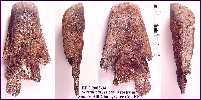 |
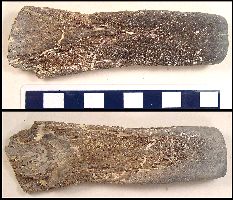 |
Two additional Martinichthys discoveries (2005) from Gove
County, KS. LEFT: A fairly large M. ziphioides rostrum (Top =
dorsal view; bottom = ventral view). This specimen also appears to be partially digested,
leaving me to wonder if many or most of the remains we have found have been the remains of
a meal... might explain why we don't find additional post-cranial material. Maybe Martinichthys
tasted really good.
Right: A damaged but apparently bitten and partially digested Martinichthys
rostrum. |
 |
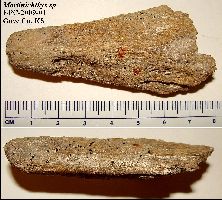 |
LEFT: My most recently collected specimen.. EPC 2009-01 (May,
2009)... from just below MU4 in southeastern Gove County. Like many others that I have
collected, it appears to be partially digested. RIGHT: A shell
coprolite collected from another locality in Gove County, discovered sitting on top of
Marker Unit 5. Preservation is unusual in this case, in part because the coprolite
was preserved sitting on the edge of an inoceramid shell. Note that the cross section shows nothing but ground up
oyster (Pseudoperna) shells. |
 |
Other
Oceans of Kansas webpages on Late Cretaceous fish:
Field Guide to Sharks and Bony
Fish of the Smoky Hill Chalk
Sharks:
Kansas Shark Teeth
Cretoxyrhina and Squalicorax
Ptychodus
Chimaerids
Bony Fish
Pycnodonts and Hadrodus
Plethodids:
Pentanogmius
Martinichthys
Thryptodus
Bonnerichthys
Protosphyraena
Enchodus
Cimolichthys
Pachyrhizodus
Saurodon and Saurocephalus
Xiphactinus
References:
Cope, E. D., 1873. [On an
extinct genus of saurodont fishes]. Proc. Acad. Nat. Sci. Phil. 24;280-281. (meeting
of Dec. 17, 1872) Wherein Cope names of the genus Erisichthe and describes Erisichthe
(Protosphyraena) nitida). <EM>
Cope, E. D., 1877. On the genus Erisichthe. Bull. U. S.
Geol. and Geog. Surv. iii, article xx. pp. 821-823. (the description and naming of Erisichthe
(Martinichthys) ziphioides)
Everhart, M. J. and P. A. Everhart, 1993. Notes on the
biostratigraphy of the plethodid Martinichthys in the Smoky Hill Chalk (upper
Cretaceous) of western Kansas. Kansas Academy of Science, Transactions, 12(Abstracts):36.
Everhart, M. J. and P. A. Everhart, 1994. Evidence of predation on
the rare plethodid Martinichthys in the Smoky Hill Chalk (upper Cretaceous) of
western Kansas. Kansas Academy of Science, Transactions, 13(Abstracts):36.
Hay, O. P., 1903. On certain genera and species of North American
Cretaceous actinopterous fishes. Bull. Amer. Mus. Nat. Hist. XIX 1-95, pls. i-v, 72
text-figs.
McClung, C. E., 1926. Martinichthys, a new genus of
Cretaceous fish from Kansas, with descriptions of six new species. Proc. Amer. Philos.
Soc. 65 no. 5, (suppl.) 20-26, 2 pls.
Taverne, L., 1999. Révision du genre Martinichthys,
poisson marin (Teleostei, Tselfatiirormes) du Crétecé supérior du Kansas (États-Unis).
Geobios 33(2):211-222. (Revision of the genus Martinichthys, marine fish
(Teleostei, Tselfatiiformes) from the Late Cretaceous of Kansas (United States))
Taverne, L. and Gayet, M. 2005. Phylogenetical relationships and
palaeozoogeography of the marine Cretaceous Tselfatiiformes (Teleostei, Culpeocephala).
Cymbium 29(1): 65-87 <LT>
More about Martinichthys -
The Mystery Fish of the Smoky Hill Chalk
Oyster Shell Structures or Martinichthys
Coprolites?





